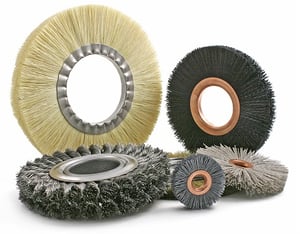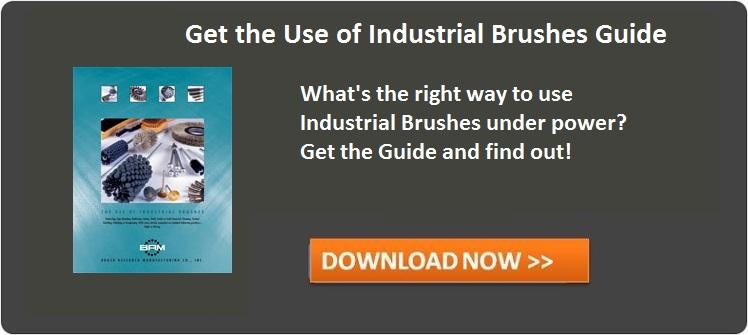 Power brushes are handheld or machine-based brushing tools for surface preparation, deburring, and surface finishing. Applications include edge blending, weld cleaning, rust or paint removal, parts polishing, and wire stripping.
Power brushes are handheld or machine-based brushing tools for surface preparation, deburring, and surface finishing. Applications include edge blending, weld cleaning, rust or paint removal, parts polishing, and wire stripping.
As their name suggests, power brushes are designed for use under power. Depending upon the brush type and application, they can be used with a high-speed handheld tool such as an electric drill, or with machinery and equipment such as a bench or pedestal grinder. Many different types of power brushes are available, but buyers need to consider more than just brush type.
Follow Brush Safety Guidelines
Manufacturers, machinists, and hobbyists who use power brushes also need to adhere to safety guidelines. During normal operations, these industrial brushing tools spin rapidly so that their filaments “brush away” unwanted materials such as burrs, scale, paint chips, and weld slag. Operators can be struck by the material that’s being removed, and metal filaments can also break-off. Since failure to observe safety precautions may result in injury, power brush users are encouraged to read the following safety guidelines from Brush Research Manufacturing (BRM) and to follow applicable government regulations.
Wear Protective Equipment
Power brush operators and personnel within a vicinity of 50-ft. should comply with the occupational eye and face protection requirements defined in ANSI Z81.1 from the American National Standards Institute (ANSI). Always wear safety googles or a full face shield over safety goggles with side shields. Additional personal protective equipment (PPE) may vary by industry, and can include hand, foot, and hearing protection. In addition to gloves and aprons, long-sleeve shirts and full-length pants help to protect the skin. Keep all machine guards in place, and follow all equipment safety guidelines.
Obey Speed Restrictions
Power brush users should also observe the speed restrictions that are listed on brushing tools, labels and packaging, and in printed materials from the brush supplier. Never exceed a brush tool’s maximum safe free speed (MSFS). Measured in revolutions per minute (RPM), MSFS is the maximum rate of spinning without work applied. Power brush operators should also comply with requirements from the Safety Standards of the Industrial Division of the American Brush Manufacturers (ABA) Association. ANSI B165.1 also defines important safety requirements for power brushes.
Use Power Brushes Properly
For best results, avoid applying excessive amounts of pressure to the workpiece. During power brush operation, excessive pressure can cause the filaments to build-up heat, over-bend, become dull, and even break. If the power brush you’re using doesn’t provide the desired results with an appropriate amount of pressure, try a brushing tool with a more aggressive cutting action, or that supports higher speeds. If a brush is worn or working improperly, discontinue use to avoid brush failure and minimize risk of injury.
Perform Equipment and Brush Tool Maintenance
Finally, it’s important to maintain both your machinery and your brushing tools. Worn bearings, a bent spindle, and intentional or accidental misuse of equipment can affect your operations, and prevent power brushes from working properly. With wire wheels, a type of power brush, operators should periodically reverse the direction of rotation to promote self-sharpening of the metal filaments. To avoid “after rust”, store stainless steel brushes away from areas where they might contact carbon steel particles.
Learn More about Industrial Brushes
Do you have questions about how to select, use, and maintain industrial brushes? Would you like to learn about the different types of power brushes, and about the BRM Flex-Hone® for inner diameter surface finishing and deburring? Brush up on your surface finishing knowledge. Download “The Use of Industrial Brushes” today.









